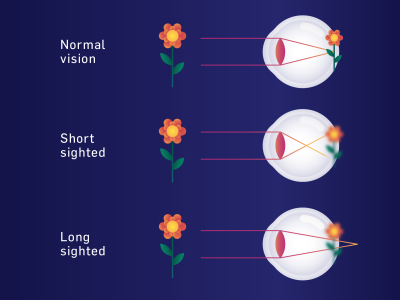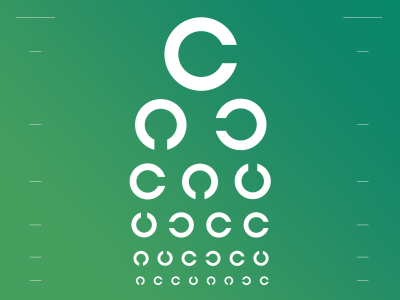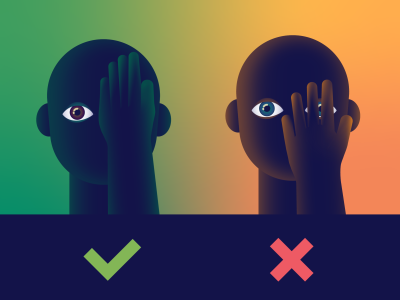Free online eye sight test
Complete an eye sight test in 2 minutes!
Browser support: Chrome, Safari, Edge and Firefox

How your eyesight works
When you direct your eye towards something, an image is formed on your retina. This image is then transported via the optic nerve up to your brain, which then tells you what you are looking at. The image on the retina is formed by light being refracted by the cornea and lens of the eye.
The refraction in the eye determines whether your eyesight is normal, or whether you are short-sighted, long-sighted or have astigmatism (a defect in the structure of your eye). The refraction controls where in the eye the images sent up to the brain via the optic nerve are formed. If you have normal eyesight, the images will be formed exactly on the retina, and you will see a clear image.
If you squint your eyes to see objects far away, you will usually be short-sighted, whereas you will be long-sighted if you have difficulty seeing close objects. So, if you are short-sighted, you see objects closest to you best, and if you are long-sighted, you see objects far away best. If you are short-sighted, the image is formed in front of the retina, and if you are long-sighted, the image is formed behind the retina. Both examples mean that you are cannot see clearly.

If there are errors in the refraction, the image formation on the retina will be blurry. The general term for short-sightedness, long-sightedness and refractive error is astigmatism. These defects can be corrected using eyeglass lenses or contact lenses. The strength of the lens is indicated in dioptres. The dioptre value is indicated with + or -. This shows whether the correction is for long-sightedness (+) or short-sightedness (-). The higher the dioptre value, the greater the refractive error.
Astigmatism occurs because the cornea and/or the lens has mismatched curves. This means that the image formation is distorted on the retina, resulting in you not seeing clearly. Most people have slight astigmatism they do not notice. Severe astigmatism can be congenital or arise due to diseases in the cornea or in the lens. Glasses and contact lenses can correct astigmatism. Astigmatism is usually discovered by an optician when your eyesight becomes blurry and you need glasses.
When focusing on an object, such as the pages in a book, you not only see the book in front of you, but also the table-top on which the book is lying as well as the surrounding objects and the objects at the back of the room. But you do not really notice this, because your focus is on the pages in the book. When you focus on something, you use your central vision, and when you sense your surroundings without looking directly at them, you use your peripheral vision. You also use your peripheral vision in the dark, as your peripheral vision can sense weaker light than your central vision. Your central vision is measured when your visual acuity (eyesight) is measured.

When we are around 40-50 years old, most of us will experience that we find it difficult to see clearly close up. This is called "adult vision" and occurs because the lens of the eye becomes less flexible with age and it becomes harder for the eye to focus on objects close up. In most cases this problem can be solved with reading glasses.
How short- or long-sighted you are is determined through an eyesight test. You can probably remember the doctor's eye charts with symbols and figures from your childhood. The charts you meet as an adult have letters or numbers placed in rows, with the largest letters and numbers at the top and the smallest at the bottom. The more letters you can read from the bottom row at a fixed distance, the better your visual acuity. Visual acuity is often indicated in per cent, where 100% is normal vision. To drive, you must have vision when using both eyes of at least 50%. Glasses or contact lenses may be used.

There is a difference between visual acuity and the optical strength (the strength of the lenses in your glasses). Visual acuity can only be measured if you yourself play an active role and say how much you can see during an eyesight test, while optical strength can be measured by the optician or the eye care specialist (ophthalmologist) alone.
You can check your own eyesight and get a sense of whether it is working as it should. You can check it by first covering one eye with your hand and then the other. If you normally wear glasses or contact lenses, keep them on. Can you see equally well with both eyes? Or is there a difference? Keep track of whether your eyesight is changing. If it changes, contact an optician. The same applies if you suddenly experience other changes in your eyesight, such as:
In short: Keep track of your eyesight, and contact an optician if it changes.

Complete an eye sight test in 2 minutes!
Browser support: Chrome, Safari, Edge and Firefox
